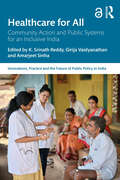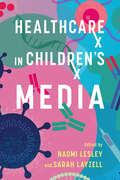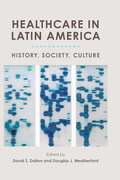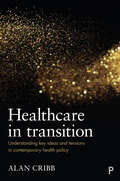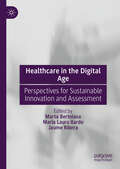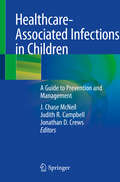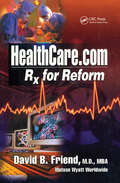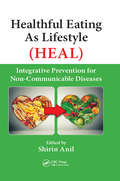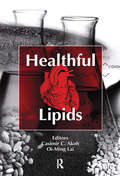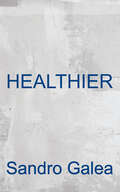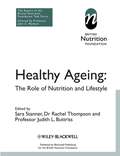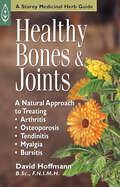- Table View
- List View
Healthcare as a Universal Human Right: Sustainability in Global Health
by Rui NunesThis important book outlines how, despite varying levels of global socio-economic development, governments around the world can guarantee their citizens’ fundamental right to basic healthcare. Ground in the philosophical position that healthcare is an essential element to human dignity, the book moves beyond this theoretical principle to offer policy makers a basis for health policies based on public accountability and social responsiveness. Also emphasizing the importance of global co-operation, particularly in the area of health promotion and communication, it addresses, too, the issue of financial sustainability, suggesting robust mechanisms of economic and social regulation. New opportunities created by e-health, evidence-based data and artificial intelligence are all highlighted and discussed, as is the issue of patient rights. Students and researchers across bioethics, public health and medical sociology will find this book fascinating reading, as will policy makers in the field.
Healthcare for All: Community Action and Public Systems for an Inclusive India (Public Policy in India)
by K. Srinath Reddy Amarjeet Sinha Girija VaidyanathanThis book offers a comprehensive analysis of India’s healthcare challenges and the pathways to achieving universal health coverage. It critically examines the current healthcare landscape, highlighting persistent issues such as undernutrition, demographic transitions, and pandemic vulnerabilities.The book emphasises the importance of strengthening public healthcare systems, investing in human resources, and adopting a community-centred approach to health policy. It discusses the need for decentralised community action, substantial public investment in healthcare infrastructure, addressing urban health challenges, and developing a more inclusive and accessible healthcare model. Drawing on microstudies from across different states, the volume offers evidence-based recommendations for policymakers to transform India’s healthcare ecosystem and make quality healthcare a reality for all. Its multidisciplinary approach – spanning healthcare policy, economics, and social development – ensures relevance across diverse professional domains while maintaining a clear focus on healthcare improvement in India. This broad yet focused perspective makes it a valuable resource for both specialists in the field and those seeking to understand the complexities of India’s healthcare challenges and solutions.Part of the Innovations, Practice and the Future of Public Policy in India series, this open access volume will interest policy professionals, administrators, academics, and researchers in public health, healthcare economics, and development studies.This book is freely available as a downloadable Open Access PDF at http://www.taylorfrancis.com under a Creative Commons (CC-BY-NC-ND) 4.0 license.
Healthcare in Children's Media (Children's Literature Association Series)
by Naomi Lesley Sarah LayzellContributions by Anna Bugajska, Dayna Campbell, Dallas Ducar, Sudeshna Shome Ghosh, Melanie Goss, Joseph Holloway, Jeremy Johnston, Manjushri Karthikeyan, Jenise Katalina, Sarah Layzell, Naomi Lesley, Anna Macdonald, Vanessa E. Martínez-Renuncio, Nichole Mayweather-Banks, Madison Miner, Dawn Sardella-Ayres, Farriba Schulz, Carrie Spencer, Antje Tannen, Valerie A. Ubbes, and B.J. Woodstein Healthcare in Children’s Media, edited by Naomi Lesley and Sarah Layzell, is a collection of essays and interviews from scholars, activists, and practitioners grappling with crucial questions about representations of healthcare systems, both formal and informal, in children’s media. The volume focuses on systems of healthcare rather than individual narratives of illness. It examines how children are socialized into knowledge about healthcare. Essays explore critiques of existing systems embedded in children's literature, analyze how children’s books might be used for health literacy education, and examine children’s film and television for visions of alternative systems and solutions to ethical dilemmas. Contributors in Healthcare in Children’s Media draw upon interdisciplinary approaches including disability studies, gender studies, public health, bibliotherapy, and posthumanism. Essays examine care systems in the US, the UK, Germany, India, and Iran, and also offer a breadth of historical perspective ranging from the turn of the twentieth century through our present times and into projections of future bioethical and posthuman dilemmas. This volume adds fresh works to archives of health literacy books, with analytic perspectives on race and disability that medical writers might not consider.
Healthcare in Latin America: History, Society, Culture
by David S. Dalton and Douglas J. WeatherfordIllustrating the diversity of disciplines that intersect within global health studies, Healthcare in Latin America is the first volume to gather research by many of the foremost scholars working on the topic and region in fields such as history, sociology, women’s studies, political science, and cultural studies. Through this unique eclectic approach, contributors explore the development and representation of public health in countries including Argentina, Bolivia, Brazil, Chile, Colombia, Cuba, Ecuador, El Salvador, Guatemala, Mexico, Nicaragua, Puerto Rico, and the United States. They examine how national governments, whether reactionary or revolutionary, have approached healthcare as a means to political legitimacy and popular support. Several essays contrast modern biomedicine-based treatment with Indigenous healing practices. Other topics include universal health coverage, childbirth, maternal care, forced sterilization, trans and disabled individuals’ access to care, intersexuality, and healthcare disparities, many of which are discussed through depictions in films and literature. As economic and political conditions have shifted amid modernization efforts, independence movements, migrations, and continued inequities, so have the policies and practices of healthcare also developed and changed. This book offers a rich overview of how the stories of healthcare in Latin America are intertwined with the region’s political, historical, and cultural identities.Contributors: Benny J. Andrés, Jr. | Javier Barroso | Katherine E. Bliss | Eric D. Carter | David S. Dalton | Carlos S. Dimas | Sophie Esch | Renata Forste | David L. García León | Javier E. García León | Jethro Hernández Berrones | Katherine Hirschfeld | Emily J. Kirk | Gabriela León-Pérez | Manuel F. Medina | Christopher D. Mellinger | Alicia Z. Miklos | Nicole L. Pacino | Douglas J. Weatherford Publication of this work made possible by a Sustaining the Humanities through the American Rescue Plan grant from the National Endowment for the Humanities.
Healthcare in Transition: Understanding Key Ideas and Tensions in Contemporary Health Policy
by Alan CribbHealth policy thinking must change. This book explores the fundamental currents and tensions that lie behind recent trends such as shared decision-making, co-production, and personalisation. These are often discussed in relation to an epidemiological transition but this text argues that they embody a philosophical transition – a change in our conceptions of healthcare and of appropriate forms of knowledge and analysis. As clinical concerns are increasingly nested within social concerns then policy analysis must engage with the multiple philosophical tensions that are now centre stage. This focus on key underlying ideas and tensions in healthcare couldn’t have come at a better time. With international relevance, the book’s arguments help fuel a shift away from a ‘delivery’ model towards a more deliberative model of healthcare.
Healthcare in the Digital Age: Perspectives for Sustainable Innovation and Assessment
by Jaume Ribera Marta Bertolaso Maria Laura IlardoThis book offers a comprehensive exploration of the dynamic relationship between digital technology and healthcare delivery, emphasising sustainable innovation in health services. It explores how digital technologies improve healthcare outcomes, enhance patient and community experiences, and streamline healthcare management, while addressing ethical, philosophical, and policy challenges tied to healthcare digitization. Examining trends such as telemedicine, AI diagnostics, data security, and the Internet of Medical Things (IoMT), the book highlights global case studies, lessons learned, and strategies for integrating these technologies sustainably. It discusses the contextual, economic, and social impacts of digital health, presenting frameworks for their evaluation and improvement. Advocating for regulatory policies that prioritise privacy, accessibility and enhance responsible initiative, the book calls for collaborative approaches. Aimed at healthcare professionals, policymakers, and academics, this resource provides insights into creating a more efficient and equitable healthcare system, aligning with the broader goals of public health and social justice.
Healthcare in the United States: Clinical, Financial, and Operational Dimensions
by Kenneth L. Johnson Stephen L. WalstonHealthcare in the United States: Clinical, Financial, and Operational Dimensions offers an introductory overview of the American healthcare system by exploring its many organizations, populations, professions, structures, financing, and delivery models, as well as their impact. Authors Stephen L. Walston and Kenneth L. Johnson delve into the many conflicting issues related to cost, access, and quality. The book's 14 chapters cover the following and more: a comprehensive review of the health professions and types of healthcare organizations; an exploration of how medical providers are paid; major challenges currently facing physicians, hospitals, and the pharmaceutical industry; an examination of the long-term and mental healthcare sectors and the increasing demands for their services; the significant role of the government in healthcare, including the influence of politics; the basics of population health, including an in-depth look at how changing social, demographic, and economic conditions in the United States affect healthcare; the connections between health behaviors, health insurance, and health outcomes; information technology's role in healthcare; a comparison of US healthcare to that in other countries, with a focus on the four basic models on which most healthcare systems are created. To enhance and assess students' learning, each of the book's chapters features case studies, thought-provoking questions and assignments, sidebars, and key terms accompanied by definitions. As they read, future healthcare administrators and clinicians will obtain a grounding in the multifaceted US healthcare system, thus enabling them to better address its multiple priorities, controversies, and opportunities.
Healthcare, Insurance, and You
by Lisa ZamoskyHealthcare is changing and you need to know how--and what to do about it. Getting good medical care shouldn't be so confusing--or so costly. Healthcare, Insurance, and You simplifies the many confusing details about our healthcare system so you can make informed decisions. Result? Better health at lower cost. With the advent of healthcare reform, things are changing--especially when it comes to insurance. Most people will now have to buy insurance. Do you know where to get a policy or what to look for in one? Did you know more people will now qualify for free or subsidized healthcare? Even if you get insurance through work, you'll face new choices that you'd better understand to maintain your peace of mind. As this book shows, the failure to understand how insurance and the healthcare system work can have a major impact on your physical and financial health. Healthcare, Insurance, and You is an easy-to-use guide that explains the main challenges you face when trying to get excellent healthcare: choosing the best insurance policy for your situation, finding the right doctor or hospital, buying prescription drugs the least expensive way, picking out the right Medicare plan, or fighting for your rights when dealing with insurers or medical providers. Healthcare, Insurance, and You includes tips, resources, and strategies for navigating the healthcare system and avoiding common mistakes so you can get the best healthcare for you, your family, or your organization without breaking the bank. This book shows you: How to choose a health plan that best meets your medical and financial needs, including new options under the Affordable Care Act Ways to cut through red tape and fight billing errors and claim denials What businesses need to know about offering--or not offering--insurance to employees How to plan ahead for a disability or for end-of-life care Healthcare costs rank high on the list of money concerns Americans have. And when it comes to getting great healthcare for you and your family and avoiding crippling medical bills, knowledge is power. Healthcare, Insurance, and You is a practical guide that explains the complicated healthcare system in plain language--and puts the power of good health back in your hands. What you'll learn The impact of the Affordable Care Act on your healthcare and your finances How to take advantage of new health insurance exchanges and tax credits How to choose a health plan that best meets your medical and financial needs How to advocate for yourself, fight billing errors and denied claims, and know where to turn for help How to choose a doctor and hospital based on quality, not hype How to avoid common mistakes that can cost you big--or even put you into bankruptcy How health reform affects businesses and how they can reduce healthcare expenditures Who this book is for Consumers of healthcare in the United States, including both individuals and small businesses buying coverage for employees. Table of Contents A New Healthcare System Buying Health Insurance on your own Paying for Health Insurance Health Insurance at Work Cutting Medical Costs Buying Prescription Drugs You Against the Healthcare System Medicare Taking Charge of Your Healthcare Future Consumer Assistance Programs and State Departments of Insurance
Healthcare-Associated Infections in Children: A Guide to Prevention and Management
by J. Chase McNeil Judith R. Campbell Jonathan D. CrewsWith advances in technology and medical science, children with previously untreatable and often fatal conditions, such as congenital heart disease, extreme prematurity and pediatric malignancy, are living longer. While this is a tremendous achievement, pediatric providers are now more commonly facing challenges in these medical complex children both as a consequence of their underlying disease and the delivery of medical care. The term healthcare-associated infections (HAIs) encompass both infections that occur in the hospital and those that occur as a consequence of healthcare exposure and medical complexity in the outpatient setting. HAIs are associated with substantial morbidity and mortality for the individual patient as well as seriously taxing the healthcare system as a whole. In studies from the early 2000s, over 11% of all children in pediatric intensive care units develop HAIs and this figure increases substantially if neonatal intensive care units are considered. While progress has been made in decreasing the rates of HAI in the hospital, these infections remain a major burden on the medical system. In a study published in 2013, the annual estimated costs of the five most common HAIs in the United States totaled $9.8 billion. An estimated 648,000 patients developed HAIs in hospitals within the US in 2011 and children with healthcare-associated bloodstream infection have a greater than three-fold increased risk of death.While a number of texts discuss HAIs in the broader context of infectious diseases or pediatric infectious diseases (such as Mandell’s Principles and Practice of Infectious Diseases or Long and Pickering’s Principles and Practice of Pediatric Infectious Diseases) no single text specifically focuses on the epidemiology, diagnosis and management of HAI in children. Many infectious diseases texts are organized based on the microbiology of infection and from this starting point then discussing the clinical syndromes associated with the organism of interest. For instance, a chapter on Staphylococcus aureus may contain a brief discussion of the role of S. aureus in surgical site infections in the wider context of all staphylococcal disease. For clinicians caring for children at the bedside, however, the clinical syndrome is typically appreciated and intervention necessary prior to organism identification. We propose a text that details both the general principles involved in HAIs and infection prevention but also provides a problem oriented approach. Such a text would be of interest to intensivists, neonatologists, hospitalists, oncologists, infection preventionists and infectious diseases specialists. The proposed text will be divided into three principle sections: 1) Basic Principles of Infection Control and Prevention, 2) Major Infectious Syndromes and 3) Infections in Vulnerable Hosts. Chapters in the Major Infectious Syndromes section will include discussion of the epidemiology, microbiology, clinical features, diagnosis, medical management (or surgical management as appropriate) and prevention of the disease entity of interest. Chapters will seek to be evidenced based as much as possible drawing from the published medical literature as well as from clinical practice guidelines (such as those from the Infectious Diseases Society of America) when applicable. We intend to include tables, figures and algorithms as appropriate to assist clinicians in the evaluation and management of these often complex patients. Finally, we intend to invite authors to participate in this project from across a number of medical specialties including infectious diseases, infection control, critical care, oncology and surgery to provide a multidisciplinary understanding of disease. It is our intent to have many chapters be co-written by individuals in different subspecialties; for instance, a chapter on ventilator-associated pneumonia may be co-written by both infectious disease and critical care medicine specialists. Such a unique text has the potential to provide important guidance for clinicians car
Healthcare.com: Rx for Reform
by David FriendDespite more than a decade of change, the U.S. health care delivery system is still in the early stages of its transformation into a truly effective, cost efficient and compassionate system. In Healthcare.com: RX for Reform, Dr. David Friend, trained in both medicine and business, delineates the symptoms of our ailing healthcare system and offers a vision for the future. Even with the enormous turmoil our health care system has undergone - from the proliferation managed care to the closing of hospitals - large numbers of people continue to receive sub-optimal care. The author discusses several symptoms including: increasing costsuncertain quality of careeroding trust in health care vendorsincreasing prospect of shareholder liabilitydeclining access to providersunclear impact on employee productivityIt is time to discard the old, traditional way of thinking about healthcare and take a fresh look at its issues and challenges. To tackle these challenges we must strike a balance between the seemingly dissimilar disciplines of economics, medicine, technology, and politics. Dr. Friend proposes that we tear down the brick and mortar delivery model and replace it with a Virtual Health Care System. This new model changes the roles of everyone involved in the healthcare system, from the patient to the healthcare provider. It utilizes technology to redesign health care so that it can be delivered with higher quality and greater efficiency. Healthcare.com: RX for Reform examines the actions necessary for the evolution of our current system into a Virtual Health Care System.Features
Healthful Eating As Lifestyle (HEAL): Integrative Prevention for Non-Communicable Diseases
by Shirin AnilNon-communicable diseases (NCDs) are chronic diseases of long duration and generally slow progression, including cardiovascular diseases, cancers, chronic respiratory diseases, and diabetes. Morbidity and mortality due to non-communicable disease has risen tremendously over the years globally. Healthful Eating As Lifestyle (HEAL): Integrative Prevention for Non-Communicable Diseases highlights the importance of HEAL as an intervention for the prevention and cure of NCDs, as well as the prevention and treatment of its risk factors like hypertension, high cholesterol, obesity, smoking, increased alcohol intake, and insufficient physical activity. It provides motivational strategies for users of all ages, gender, and strata for healthful eating, both in developed and developing countries. The book is composed of evidence-based information and illustrations by 32 experts, including renowned researchers from academia, government, and non-governmental organizations in the field of NCDs and nutrition from 11 countries across five continents. Furthermore, the book discusses the dose-response relationship of healthful food with NCDs and its risk factor. It also includes nutritional home remedies for prevention and control of NCDs along with safety concerns and case studies at the end of all chapters for translating theory into practice.
Healthful Lipids
by Casimir C. AkohHealthful Lipids addresses critical and current regulatory issues and emerging technologies, as well as the efforts made toward the production of healthier lipids. This book examines the latest technological advancements and the emerging technologies in processing and analysis, health-related concerns, and strategies used in the production and appl
Healthier: Fifty Thoughts on the Foundations of Population Health
by Sandro GaleaPublic health can rightly claim its share of victories: healthier cities, widespread sanitation, broader availability of nutrient-rich food, and reductions in violence and injury. But for all these gains, today we face a new set of challenges, ones complicated by political and professional shifts that threaten to fundamentally change the health of populations.
Healthy Ageing
by Bnf Judith L. Buttriss Rachel Thompson Sara StannerYear on year, countries across the world continue to see an increase in life expectancy, largely attributed to the impact of modern medicine and disease eradication. There is now increasing evidence that environmental factors such as diet and lifestyle also have a significant role to play.However with this increase in years there often comes an unfortunate rise in chronic morbidity, with the quality of later life severely compromised by ill health.With age being the single greatest risk factor for a large proportion of common medical conditions, this latest report from the British Nutrition Foundation looks in detail at the role nutrition and physical activity can play in ensuring that the older adults of tomorrow can lead not only longer, but healthier lives.Written by a team of well known and respected expertsDescribes the role of diet and lifestyle in the ageing process of the major body organs and tissues including the brain, heart, gastrointestinal tract, musculoskeletal tissues, eyes, teeth and skin, as well as immune and endocrine systemsProvides essential information for anyone involved in promoting health and quality of life for older peopleEach chapter includes a summary of the key points, as well as important recommendations to help identify long-term strategies for healthy ageingAn overview of the main messages of the report are provided in a practical question and answer format suitable for lay readersFull of invaluable information on a subject which is set to increase in importance as the average age of populations rise worldwide, this book is crucial reading for students of nutrition, dietetics and food science, clinical nutritionists, public health nutritionists and policy makers. It will also provide an excellent reference for those working in the food industry and for nutritional supplement manufacturers and pharmaceutical companies.
Healthy Ageing in Asia: Culture, Prevention and Wellness
by Gerard Bodeker Kishan Kariippanon Goh Cheng SoonAsia is the world’s most populous region and has the highest per capita number of older people in the world. It is also home to the healthy ageing traditions of Ayurveda and Chinese Medicine and the rich regional traditions of Japan, Korea, Southeast Asia, and South Asia. This book addresses policies related to ageing, traditional Asian approaches to ageing, an integrated medical system approaches to ageing, ageing in place, and community empowerment. Features Presents information on The 100-Year Life. As a counterpoint to focussing on the frail elderly, Japan is promoting the ‘100-Year Life Society’, a societal model in which all citizens are dynamically engaged and productive throughout the lifespan to reach a healthy 100 years of age. Discusses a framework for optimization of Ageing in Place or staying at home as this is a desired option for most older people. Presents evidence for exercise and movement in healthy aging with guidelines in different states of ageing. Features information on how to improve mental wellbeing in cognitive decline, isolation and loneliness, poor nutrition, and reduced mobility. Creates an understanding of loss and bereavement through processes and the impact of loss. Provides information on developments in health technology to optimize efficiency, accuracy, and effectiveness of providers. Details health insurance options including coverage for traditional as well as modern medical services, provides models for other countries in the region. Lists coping skills or abilities to help older people to be more independent and in control of their lives. Features information on Asian herbs, spices and foods in healthy ageing across the lifepsan and specifically in addressing age-related health issues. "What is required is a new culture based on the science in which older people are expected to remain, or become increasingly active, physically, cognitively and emotionally maintaining or strengthening a strong sense of purpose. Europe is looking to Asia because this culture is more prevalent there than in Europe. The core theme is not one of ‘caring’ for a passive subset of the population but of promoting lifelong learning because knowledge is the elixir of life." - Professor Sir Muir Gray, Founding Director, The Optimal Ageing Programme & Professor in the Nuffield Department of Surgery, University of Oxford
Healthy Ageing in Singapore: Opportunities, Challenges and the Way Forward (Social Policy and Development Studies in East Asia)
by Sabrina Ching Yuen LukSingapore is the world’s second-fastest ageing society and will become a super- aged society by 2030. This book fills an important research gap by examining Singapore’s efforts to achieve healthy ageing. It draws on both semi-structured interviews and secondary data (e.g. government documents, journal articles, books, reports) to examine hot topics such as financial wellness of older adults, ageing in place, dementia friendly communities and digital connection with older adults in the time of the 2019 coronavirus disease (COVID-19). In the interviews, experts and professionals provide valuable insights into the issue of healthy ageing in Singapore. The book ’s goal is to provide a comprehensive portrait of healthy ageing in Singapore, while also sharing valuable lessons to help other countries achieve healthy ageing.
Healthy Aging in Asia
by Karen EgglestonLife expectancy in Japan, South Korea, and much of urban China has now outpaced that of the United States and other high-income countries. With this triumph of longevity, however, comes a rise in the burden of noncommunicable diseases (NCDs) like diabetes and hypertension, reducing healthy life years for individuals in these aging populations, as well as challenging the healthcare systems they rely on for appropriate care. The challenges and disparities are even more pressing in low- and middle-income economies, such as rural China and India. Moreover, the COVID-19 pandemic has underscored the vulnerability to newly emerging pathogens of older adults suffering from NCDs, and the importance of building long-term, resilient health systems. What strategies have been tried to prevent NCDs—the primary cause of morbidity and mortality — as well as to screen for early detection, raise the quality of care, improve medication adherence, reduce unnecessary hospitalizations and increase "value for money" in health spending? Fourteen concise chapters cover multiple aspects of policy initiatives for healthy aging and economic research on chronic disease control in diverse health systems — from cities such as Singapore and Hong Kong to large economies such as Japan, India, and China.
Healthy Aging: A Complete Guide to Clinical Management
by Patrick P. CollThis book weaves all of these factors together to engage in and promote medical, biomedical and psychosocial interventions, including lifestyle changes, for healthier aging outcomes. The text begins with an introduction to age-related changes that increase in disease and disability commonly associated with old age. Written by experts in healthy aging, the text approaches the principles of disease and disability prevention via specific health issues. Each chapter highlights the challenge of not just increasing life expectancy but also deceasing disease burden and disability in old age. The text then shifts into the whole-person implications for clinicians working with older patients, including the social and cultural considerations that are necessary for improved outcomes as Baby Boomers age and healthcare systems worldwide adjust. Healthy Aging is an important resource for those working with older patients, including geriatricians, family medicine physicians, nurses, gerontologists, students, public health administrators, and all other medical professionals.
Healthy Aging: A Lifelong Guide to Your Physical and Spiritual Well-Being
by Andrew WeilAndrew Weil M.D. offers information on nutrition, diet and exercise to promote graceful and healthy aging.
Healthy Back Anatomy: A Chiropractor's Guide to a Pain-Free Back (Anatomies Of Ser.)
by Philip StrianoAnyone who's ever had back pain knows how debilitating it can be. From a slight twinge when you walk to an all-consuming ache, it can keep you from working out, working at the office, and even getting out of bed. Luckily, there are ways to both prevent and relieve back pain-and they're detailed in Healthy Back Anatomy.Written by a leading chiropractor, Healthy Back Anatomy features a range of exercises that help strengthen and stabilize the muscles of your back. Each move includes step-by-step instructions, plus full-color photos and anatomical illustrations that let you see how your muscles work. You'll see what muscles you're targeting and learn how to avoid injuring them. And, when you're ready, you'll even have modifications to make the moves harder and challenge yourself further. It's a complete program that includes stretches, balance and posture exercises, and lower back, neck, shoulder, and core exercises, as well as warm-ups and cool-downs.When you're hurting, having a pain-free back can sometimes seem impossible. But with this book, your health is in your hands!
Healthy Bones & Joints: A Natural Approach to Treating Arthritis, Osteoporosis, Tendinitis, Myalgia & Bursitis (A\storey Medicinal Herb Guide Ser.)
by David HoffmannStrengthen your bones and joints naturally! David Hoffman offers expert advice on how herbal treatments can help those suffering from arthritis, rheumatism, osteoporosis, and other musculoskeletal ailments. Detailed profiles of popular medicinal herbs and their healing properties, clear preparation instructions, and dosage guidelines, will help you create custom-tailored remedies suitable to your individual needs. Learn how to incorporate herbs such as meadowsweet, mustard, bay tree, and more into your daily regimen to help prevent and treat aching bones and stiff joints.
Healthy Brain, Happy Life
by Billie Fitzpatrick Wendy SuzukiThe key to a happy life . . . is a healthy brainFrom the outside, it looked like Dr. Wendy Suzuki had it all. She was a world-renowned neuroscientist. She had been lauded by her peers with many prizes and had produced many highly regarded scientific publications. She had tenure at a top-ranked university, where she also ran her own lab--two of the most difficult and highly coveted positions for any scientist to attain. And yet . . .Wendy was forty, frumpy, and focused on her work one hundred percent of the time. She was single, overwhelmed by her responsibilities, and often found herself in uncomfortable, strained interactions with everyone around her. To put it simply, Wendy Suzuki needed to change her life.She set out on a journey that would transform her body, her mind, and her brain. The first step was exercise and creating a regime that would make her body more fit. In the process, Wendy found herself focusing better, working smarter, and getting more accomplished in a shorter amount of time. As her body changed, her determination grew. Wendy set out to build a more vibrant social life, spark her creativity, and engage in meditation and other mindful activities--using her expertise in neuroscience to pinpoint exactly how these actions not only made her brain work better but also made her feel, well, happy. In Healthy Brain, Happy Life, Wendy Suzuki makes the ultimate mind-body-spirit connection and shows that everything she did for her body changed her brain--and her life--for the better.Healthy Brain, Happy Life is an accessible blend of memoir and science narrative that will transform the way you think about your brain, your health, and your personal happiness. Through both groundbreaking brain research and personal stories, Wendy offers practical and fascinating ways to improve memory, engage the mind more deeply, and learn new skills that will ultimately transform your body and your life.
Healthy Buildings: How Indoor Spaces Can Make You Sick—or Keep You Well
by John D. Macomber Joseph G. AllenA revised and updated edition of the landmark work the New York Times hailed as “a call to action for every developer, building owner, shareholder, chief executive, manager, teacher, worker and parent to start demanding healthy buildings with cleaner indoor air.”For too long we’ve designed buildings that haven’t focused on the people inside—their health, their ability to work effectively, and what that means for the bottom line. An authoritative introduction to a movement whose vital importance is now all too clear, Healthy Buildings breaks down the science and makes a compelling business case for creating healthier offices, schools, and homes.As the COVID-19 crisis brought into sharp focus, indoor spaces can make you sick—or keep you healthy. Fortunately, we now have the know-how and technology to keep people safe indoors. But there is more to securing your office, school, or home than wiping down surfaces. Levels of carbon dioxide, particulates, humidity, pollution, and a toxic soup of volatile organic compounds from everyday products can influence our health in ways people aren’t always aware of.This landmark book, revised and updated with the latest research since the COVID-19 pandemic, lays out a compelling case for more environmentally friendly and less toxic offices, schools, and homes. It features a concise explanation of disease transmission indoors, and provides tips for making buildings the first line of defense. Joe Allen and John Macomber dispel the myth that we can’t have both energy-efficient buildings and good indoor air quality. We can—and must—have both. At the center of the great convergence of green, smart, and safe buildings, healthy buildings are vital to the push for more sustainable urbanization that will shape our future.
Healthy Buildings: How Indoor Spaces Drive Performance and Productivity
by John D. Macomber Joseph G. Allen“This book should be essential reading for all who commission, design, manage, and use buildings—indeed anyone who is interested in a healthy environment.” —Norman Foster A forensic investigator of “sick buildings” and Director of Harvard’s Healthy Buildings Program teams up with a CEO-turned–Harvard Business School professor to reveal the secrets of a healthy building—and unlock one of the greatest business opportunities of our time. By the time you reach eighty, you will have spent seventy-two years of your life indoors. Like it or not, humans have become an indoor species. This means that the people who design, build, and maintain our buildings can have a major impact on our health. Ever feel tired during a meeting? That’s because most offices and conference rooms are not bringing in enough fresh air. When that door opens, it literally breathes life back into the room. But there is a lot more acting on your body that you can’t feel or see. From our offices and homes to our schools and hospitals, the indoor spaces where we work, learn, play, eat, and heal have an outsized influence on our performance and wellbeing. They affect our creativity, focus, and problem-solving ability and can make us sick—dragging down profits in the process. Charismatic pioneers of the healthy building movement who have paired up to combine the cutting-edge science of Harvard’s School of Public Health with the financial know-how of the Harvard Business School, Joseph Allen and John Macomber lay out the science of healthy buildings and make the business case for owners, developers, and CEOs. They reveal the 9 Foundations of a Healthy Building, and show how tracking health performance indicators with smart technology can boost performance and create economic value. While the “green” building movement tackled energy, waste, and water, the new healthy building movement focuses on the most important (and expensive) asset of any business: its people.
Healthy Child, Whole Child
by Stuart H. Ditchek Russell H. GreenfieldShould you give your child nutritional supplements? Are vaccinations safe? Why are more and more children becoming couch potatoes? In Healthy Child, Whole Child, doctors Stuart H. Ditchek and Russell H. Greenfield answer these questions and more, offering authoritative, cutting-edge information on all aspects of children's health and wellness. Taking the position that conventional and alternative approaches to pediatric care are not mutually exclusive, they provide the newest science and most up-to-date information on: The 6 myths (and one true statement) about vaccinations The 10 powerhouse foods for your kids The 7 questions you need to ask to find out if your child is overweight The 16 herbs that are safe and effective for children How to receive more integrative care from your current pediatricianAnd more!

